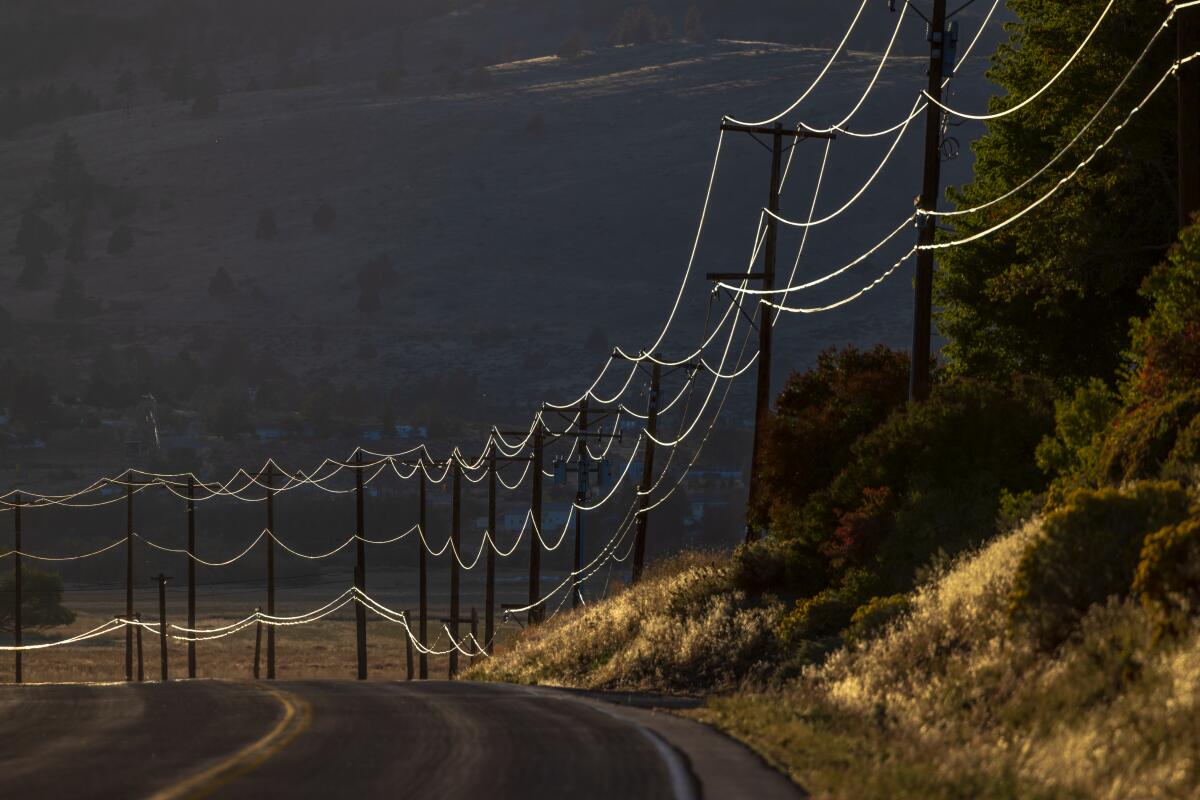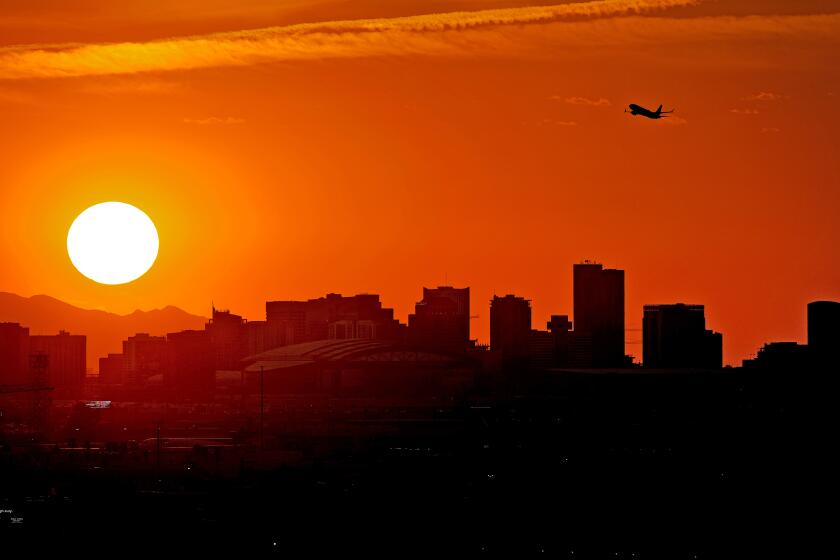Extreme heat, elevated fire risk prompt power shutoffs in Northern California

- Share via
The start of an extended, life-threatening heat wave has coincided with elevated fire conditions across Northern California, prompting Pacific Gas & Electric Co. on Tuesday to initiate the year’s first planned power shutoffs, expected to last at least through Wednesday.
The dangerous conditions were fueling several fires across the region, including one in Butte County that has prompted evacuations and another in Napa County.
The de-energized lines may prevent new fires from starting. Officials are taking any help they can get as winds, low humidity, dry vegetation and extreme heat were combining for a potentially treacherous few days. Even with the power shutoffs, several fires in Northern California started Tuesday, at least two of which prompted evacuations.
“It’s a pretty bad combination, honestly, to have a potentially record-breaking heat wave that starts off with dry north winds,” said Daniel Swain, a UCLA climate scientist, in a briefing Monday. “If that weren’t enough, this is, of course, the week of the Fourth of July holiday,” which adds literal sparks to the combustible environment.
“Buckle up,” he said. “I think California’s fire season is likely to escalate considerably over the next five to seven days.”
PG&E, California’s largest power provider, implemented public-safety shutoffs Tuesday morning across eight counties — Butte, Colusa, Lake, Napa, Solano, Sonoma, Tehama and Yolo — “due to high winds and dry conditions,” according to the utility’s website. The shutoffs are meant to prevent its equipment from sparking fires during dangerous conditions.
PG&E said the shutoffs affected approximately 2,000 customers. It said in a statement that it had “delayed the start” of planned shutoffs for about 10,000 others, mostly in Glenn and Shasta counties, “due to favorable weather conditions.”
Much of the Sacramento Valley and Bay Area mountains remain under a red flag warning — issued for elevated fire risk — as well as an excessive heat warning Tuesday and Wednesday. The red flag alert warns of a combination of winds up to 30 mph, low humidity and hot temperatures that “can contribute to extreme fire behavior,” according to the National Weather Service.
How can you cool off if the power’s out? Here are tips for not melting when you lose power during a heat wave.
California firefighters are battling several blazes, with at least nine igniting since Sunday, including two Tuesday in Napa and Butte counties, which face conditions conducive to fire spread. The wind-driven Toll fire in northwestern Napa County, near Calistoga, quickly spread to 41 acres and forced evacuations, according to the California Department of Forestry and Fire Protection. The Thompson fire in Butte County also forced evacuations Tuesday afternoon, growing to about 100 acres in less than an hour, according to Cal Fire. Power lines in the area were de-energized, officials said.
Crews were also fighting the Basin fire, the largest in the state, burning more than 13,000 acres in the Sierra National Forest in Fresno County as of Tuesday morning. It was 17% contained, according to Cal Fire.
That blaze is not far from the Balch Camp, an isolated community where more than 150 people were evacuated. PG&E has power infrastructure there, but none of its facilities had been affected as of Tuesday morning, a spokesperson said.
Firefighters began responding Monday to the McCain fire in San Diego County, which had grown to 1,000 acres by Tuesday morning and was 5% contained, according to Cal Fire. Local officials issued evacuations for communities near Campo that remained in effect as of noon Tuesday.
“The extremely hot weather dries out plant material, increasing the risk of wildfire,” Cal Fire warned on social media. “Avoid activities that could spark a wildfire, such as parking on dry grass, dragging chains or using equipment during the hottest parts of the day. Remember, one less spark means one less fire.”
Swain called it “essentially inevitable” that wildfires would start and grow during the heat wave, given Fourth of July fireworks, high temperatures and the build-up of grasses and brush, which have dried after exploding over two wet winters.
But authorities are reserving their most dire warnings for the extreme heat, which is expected to last a week or more in parts of the state.
“An exceptionally dangerous situation is expected to unfold over the next week as we enter a potentially historic and deadly heat event,” the National Weather Service’s Bay Area office wrote in its excessive heat warning. “Several days of temperatures well above normal will lead to compounding effects among people and infrastructure, with the possibility of numerous heat-related fatalities. ... An event of this scale, magnitude and longevity will likely rival anything we’ve seen in the last 18 years.”
Extreme heat has become the most deadly weather-related event in California and the rest of the nation as climate change had made heat waves more intense, longer and frequent. Weather officials are urging people to take this week’s conditions seriously.
“This is a prolonged heat event that will definitely bring serious concerns for heat-related illnesses if people don’t take proper precautions,” said Kate Forrest, a National Weather Service meteorologist in Sacramento. Forecasters predict triple-digit temperatures lasting for several days, with little overnight relief.
Redding could break or tie its record for the most consecutive days above 110 degrees, set over six days in 1978. The city is forecast to reach at least 110 degrees Wednesday through Monday, peaking Saturday at 116, Forrest said. There’s a chance the heat will last even longer.
“Its definitely going to be approaching that record,” she said.
Fresno could also break the record for consecutive days above 110. It’s expected to hit or exceed that temperature Wednesday through July 9. The National Weather Service is also predicting several record-breaking daily highs over the next week across the San Joaquin Valley, where temperatures will remain in the triple-digits for several days.
The excessive heat warning will be in effect through the weekend in most areas. Various regions will be under separate heat advisories tied to their specific forecasts.
California’s heat wave comes as President Biden’s administration ramped up its focus on “climate-fueled extreme weather events,” with federal officials announcing plans Tuesday to advance nationwide heat-related protections for millions of workers and to hold a White House summit on extreme heat this summer.
“Summer has just started; already tens of millions of Americans are under heat warnings. ... Ignoring climate change is deadly and dangerous and irresponsible,” Biden said Tuesday in Washington. “More people die from extreme heat than floods, hurricanes and tornadoes combined.”
Swain said it’s almost trivial to point to the role of climate change in California’s heat wave, though he said it was only one factor.
“Essentially all heat waves have a detectable human fingerprint at this point,” Swain said. “In a warming climate, heat waves become more frequent and more intense virtually everywhere on Earth, so extreme heat events — like the one that California is about to experience — have been made worse and more likely by climate change.”
A powerful high-pressure ridge will bring unusually hot temperatures to the Golden State by the middle of this week, before spreading into the Pacific Northwest.
Many parts of the Central Valley are forecast to see five to seven days over 110 degrees and nighttime temperatures that remain above 70 or 80 — conditions that give bodies almost no opportunity to recover.
While this heat event is most dangerous across inland California, even the state’s coastal communities have been included in advisories this week. Temperatures in Southern California’s western neighborhoods are forecast to reach up to 95 degrees, while San Francisco could approach 90.
Times staff writer Rachel Uranga and Jireh Ding contributed to this report.
More to Read
Sign up for Essential California
The most important California stories and recommendations in your inbox every morning.
You may occasionally receive promotional content from the Los Angeles Times.













